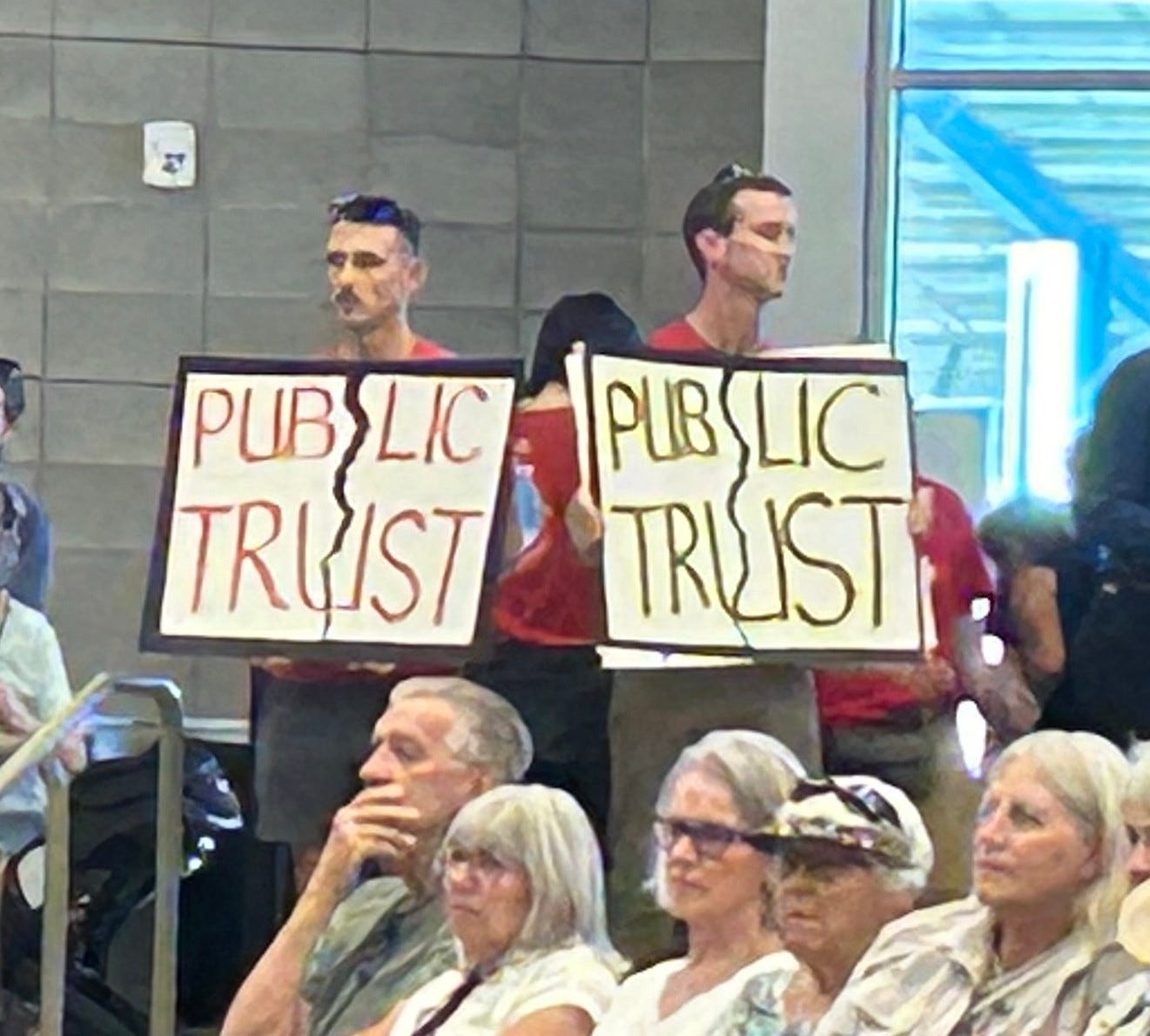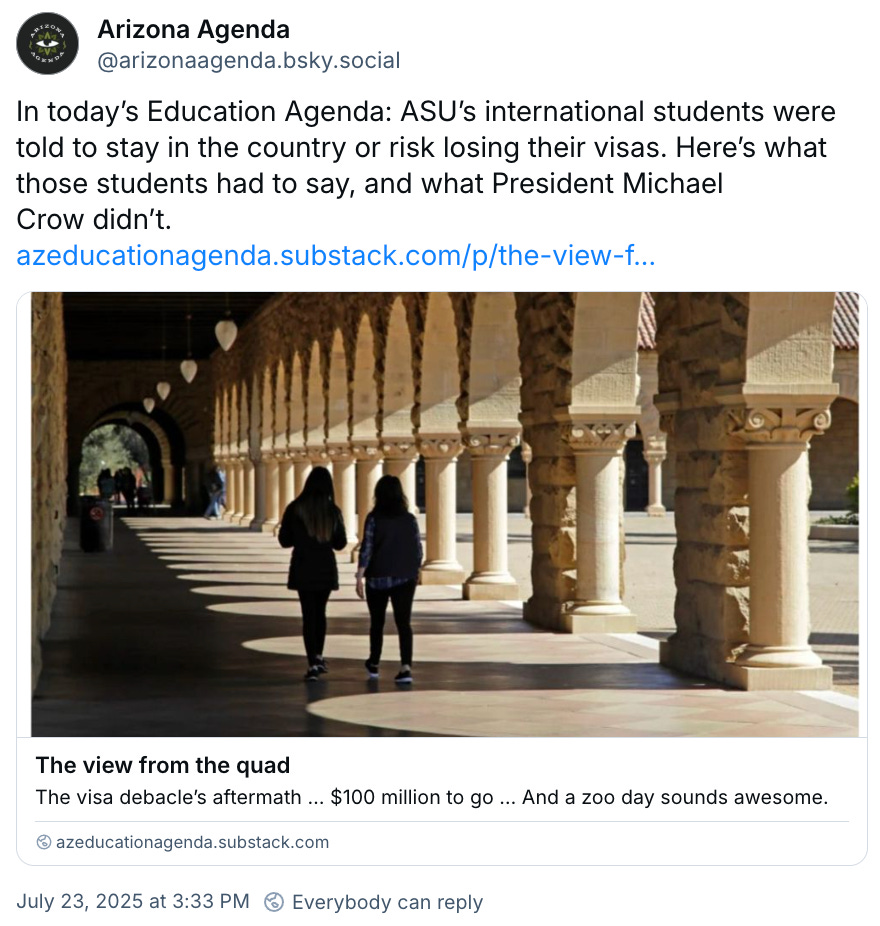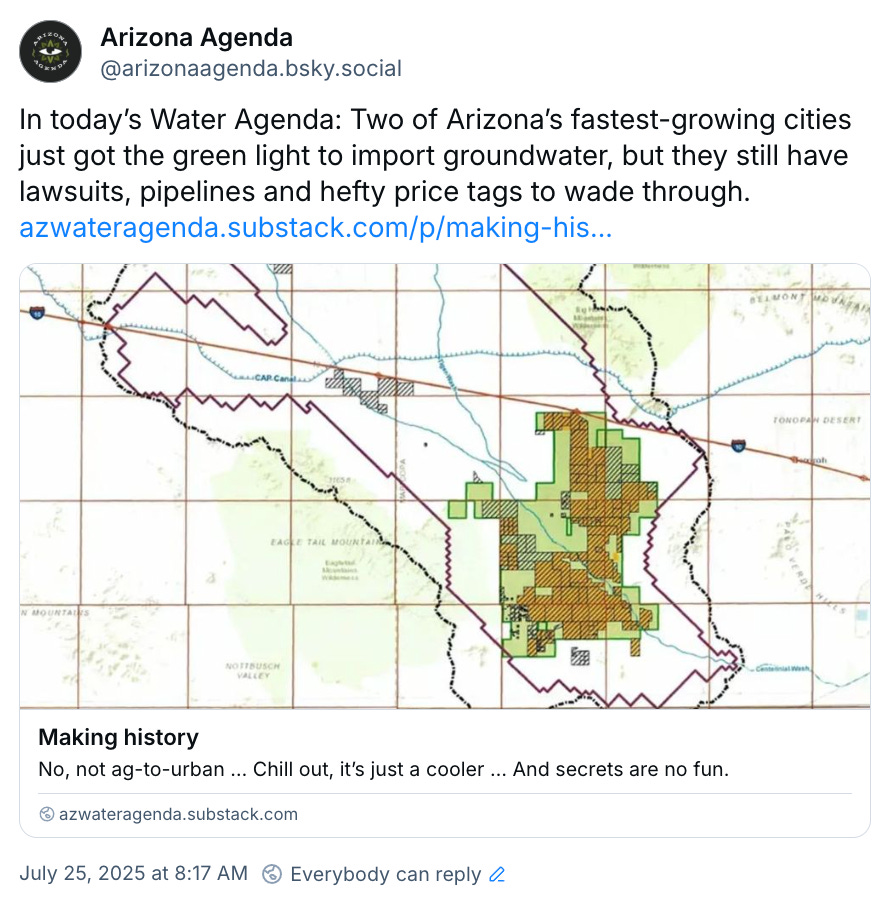Asked and answered
Project Blue's first meeting … Who is the leaker? … And a moment of Zen.
Project Blue — or “Project Bezos,” as some have started calling it — drew a fiery crowd at Wednesday night’s public meeting, which quickly devolved into prolonged shouting matches, broken up by occasional discussion about the massive economic development project planned for Tucson’s southeast side.
About 800 people packed into Mica Mountain High School near the proposed data center campus. The crowd included city and county officials, union members pushing for a commitment to use local labor during construction, and a whole lot of Tucsonans worried about water use and pollution.
We could have written this up as a straight news story, but we’re taking a different approach today — drilling down on three public questions that stood out during the meeting.
Some questions felt like softballs for the developer — maybe they were, maybe they weren’t — but we’re skipping those and focusing on what seemed like genuine exchanges between the public and either the developer or city staff.
A quick editorial note: Wednesday night’s discussion focused specifically on the initial phase of the project — a 290-acre parcel near the Pima County Fairgrounds.
Other phases — including a completely separate plan to build an even larger data center cluster somewhere else in the Tucson area — weren’t discussed during the two-hour meeting.
Question #1: Can we cut off the water?
“So if there's some big change — a new Colorado River agreement or if extreme drought continues (for multiple years) — does Tucson Water have the sole discretion to restrict (Project Blue's consumption)? And how would you balance data center versus residential?”
The city’s answer: Tucson Water’s deputy director, Scott Schladweiler, said the city doesn’t expect a water emergency that would trigger rationing. He pointed to the city’s One Water Plan, a long-term water strategy that includes ways to regulate large-scale industrial use of reclaimed water.
The plan, which was developed with community input, includes contingencies for reduced Colorado River allocations and calls for increasing the use of reclaimed water to reduce dependence on potable supplies.
It also outlines “Pure Water Tucson” — a long-term initiative to upgrade facilities and infrastructure so reclaimed water can eventually be turned into drinking water. The plan looks 75 years into the future.
Our take: The 2023 One Water Plan is a solid roadmap — but it’s still a guiding document, not a binding contract.
Things get more complicated with the upcoming City Council primary, which will bring at least two new members who never voted on the water plan. And with changes in budgets, water-saving tech, federal laws, and interstate compacts, Tucson’s One Water plan’s long-term goals are more aspirational than guaranteed.
The more interesting twist: Councilwoman Nikki Lee has this exact question on her list, which means the city will likely address it formally before voting on the Project Blue development agreement.
Our guess is that the final agreement will include some sort of clause capping the amount of reclaimed water the data centers can use.
Question #2: When will it really switch to reclaimed water?
“The draft agreement states that you promised to use potable, drinkable water for only two years prior to switching to reclaimed (water). (What if) oops, you know, we need to keep using potable a little while longer? The only recourse is making you pay more money. The draft agreement states water allocation caps, reclaimed water. But breaking those caps won't result in the city cutting off Project Blue's water. Instead, there will just be extra charges. Charging more does not give water back. Money is not water. Money and water are not fungible items.”
The city’s answer: City Manager Tim Thomure responded that the current draft — released to Council and the public on the same day — doesn’t yet include a mechanism to shut off the water if the developers miss that two-year goal of moving from potable to reclaimed water after the 18-mile pipeline has been built. The developers have publicly committed to starting construction of the pipeline at the same time as the development.
Thomure defended the current proposal, noting that Council hasn’t had a chance to discuss the draft yet — they didn’t meet in July — but he expects them to take it up at the August 6 City Council meeting.
Our take: No version of the draft agreement will satisfy everyone. Most members of the Council, if not all, have a running list of unresolved questions.
As we mentioned earlier, water use terms will likely become a non-negotiable part of the final agreement. If annexation moves forward next month, it could still be months before the final — and public — vote.
Question #3: Will ICE use Project Blue?
“Now that we know the company that's behind this project that the developer is acting on behalf of, which is Amazon Web Services, I also want to draw attention to the fact that in addition to being an anti-union mega corporation, Amazon Web Services works with a number of tech companies, including Palantir, which is contracting with the federal government specifically with DHS and ICE to surveil and police immigrants. … How do we know that this data center isn't being used to support companies that are actively targeting members of our community?”
Beale Infrastructure’s answer: Arnaud Dusser, their director of development, was careful not to use the word “Amazon” but said this would be a typical data center that is being used by the public — citing a huge, growing demand for traditional cloud infrastructure.
“It's something that we use every single day, every single person in this room uses in their personal lives. Our modern economy runs on it. It's absolutely integral to our modern economy in our daily lives. It's what's driving. It's really the backbone of the Internet,” he said.
Our take: It’s going to be impossible to know who will use these services once the data centers are built. If getting the actual end user was veiled in secrecy, we’re guessing they will take even more steps to keep their list of clients a well-preserved secret. Unless there is a data breach, we'll probably never know whose data is being stored in Project Blue.
One last note on Project Blue, Tucson Mayor Regina Romero issued a statement on her position on data centers. She says she's still neutral.
“There has been some speculation as to my position on Project Blue. To be clear, as Mayor, I owe it to the residents of Tucson, now and into the future, to make decisions that will protect our water resources and our environment. I continue to consider policy priorities that I think will move Tucson forward. My only position, right now, is to complete my due diligence to research, ask questions, analyze information, listen to residents, and to consider the actual draft development agreement before us.”
To date, only one member of the Council is on the record dead-set against it — Councilman Kevin Dahl.
Pima County Administrator Jan Lesher may have accidentally violated the county’s nondisclosure agreement with Project Blue when she gave Arizona Luminaria a confidential memo naming Amazon as the end user, a county spokesman told the Arizona Daily Star on Thursday.
The memo led to an exclusive story in Arizona Luminaria revealing that the county has been in private discussions with Amazon Web Services since 2023 regarding what is generally referred to as Project Blue.
County officials are investigating whether the disclosure constituted a violation of the NDA, Pima County spokesman Mark Evans told reporters Tony Davis and Charles Borla.
The Star contacted members of the Board of Supervisors, who expressed support for the county’s top official, largely characterizing the incident as unintentional and isolated.
In June, the Pima County Board of Supervisors voted 3–2 to sell a 290-acre parcel to a proxy for Amazon — the San Francisco-based Humphrey’s Peak LLC — for $20 million. The county also signed a purchase and sale agreement requiring the project to employ at least 75 permanent employees once the data centers are built.
While representatives for the developer have not publicly commented on the revelation involving Amazon Web Services, the project continues to move forward with the City of Tucson.
The city is expected to discuss annexing the parcel into city limits next month — a precursor to an elaborate plan to provide reclaimed water to the water-hungry data centers.
Another public meeting is scheduled for next week, although a location has not been announced.
The Education Agenda
International students at Arizona State University have anonymously spoken about their support (or lack thereof) from the university amid Trump’s immigration crackdown.
In this week’s edition of the Education Agenda, we checked in on Arizona State University students who took to online message boards to voice their frustration, while ASU President Michael Crow took to the Wall Street Journal to take a lukewarm stance on Trump’s rampage against universities.
Subscribe to the Education Agenda to hear what students had to say, and check out the tough choice facing Arizona’s governor on federal school vouchers, the ongoing battle over federal funding for schools and much, much more.
The A.I. Agenda
Wondering who you can trust in a world being taken over by artificial intelligence?
In this week's A.I. Agenda, our resident tech guru Adi Jagannathan opens up his Rolodex to highlight the people he relies on to stay ahead of New York Times reporters who cover A.I.
Subscribe to the A.I. Agenda to see who Adi thinks is worth listening to, and get the skinny on the Trump administration’s grand plan for the future of A.I..
Plus, updates on the big business moves in Arizona’s A.I. industry and why Stephen Fry thinks A.I. is both “thrilling and chilling.”
The Water Agenda
The Arizona Legislature may not be in session anymore, but the state government is still making moves.
In this week’s edition of the Water Agenda, two fast-growing Arizona cities just got approval for big water transfers to fuel their growth, which is the first time that’s ever been done in Arizona.
But as is usually the case with water deals, it’s more complicated than just signing off on new agreements.
Subscribe to the Water Agenda to see how much all this is going to cost, why these two cities got to go first, and what’s next.
Along the way, you’ll see what’s on the line in a San Pedro River lawsuit, what’s up with WIFA and why an HOA won’t just let a Goodyear man hand out bottles of water on hot summer days.
We captured this impromptu jam session outside of the Project Blue after the meeting was over.
And if nothing else, it reminded us of those “Moments of Zen” the Daily Show used to close their show with.














That moment of Zen was provided by the Backup Brass Band. They're a frequent fixture around town at local rallies, protests, and marches!
Great Coverage Tucson Agenda!